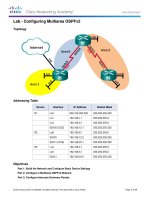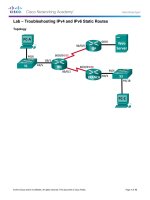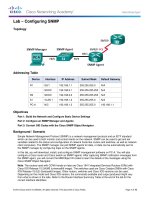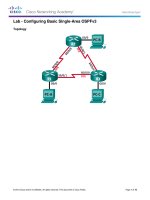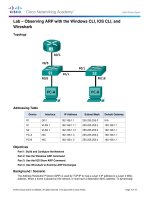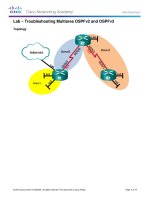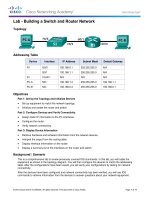10 1 4 8 lab a configure ASA basic settings and firewall using ASDM kho tài liệu bách khoa
Bạn đang xem bản rút gọn của tài liệu. Xem và tải ngay bản đầy đủ của tài liệu tại đây (1.5 MB, 39 trang )
CCNA Security
Chapter 10 - Configure ASA Basic Settings and Firewall using
ASDM
Topology
Note: ISR G1 devices use FastEthernet interfaces instead of GigabitEthernet interfaces.
© 2015 Cisco and/or its affiliates. All rights reserved. This document is Cisco Public.
Page 1 of 39
CCNA Security
Chapter 10 Lab A
IP Addressing Table
Device
Interface
IP Address
Subnet Mask
Default Gateway
Switch Port
G0/0
209.165.200.225
255.255.255.248
N/A
ASA E0/0
S0/0/0 (DCE)
10.1.1.1
255.255.255.252
N/A
N/A
S0/0/0
10.1.1.2
255.255.255.252
N/A
N/A
S0/0/1 (DCE)
10.2.2.2
255.255.255.252
N/A
N/A
G0/1
172.16.3.1
255.255.255.0
N/A
S3 F0/5
S0/0/1
10.2.2.1
255.255.255.252
N/A
N/A
VLAN 1 (E0/1)
192.168.1.1
255.255.255.0
NA
S2 F0/24
VLAN 2 (E0/0)
209.165.200.226
255.255.255.248
NA
R1 G0/0
VLAN 3 (E0/2)
192.168.2.1
255.255.255.0
NA
S1 F0/24
PC-A
NIC
192.168.2.3
255.255.255.0
192.168.2.1
S1 F0/6
PC-B
NIC
192.168.1.3
255.255.255.0
192.168.1.1
S2 F0/18
PC-C
NIC
172.16.3.3
255.255.255.0
172.16.3.1
S3 F0/18
R1
R2
R3
ASA
Objectives
Part 1: Configure Basic Device Settings
Cable the network and clear previous device settings.
Configure basic settings for routers and switches.
Configure static routing, including default routes, between R1, R2, and R3.
Enable the HTTP server on R1 and set the enable and VTY passwords.
Configure PC host IP settings.
Verify connectivity.
Part 2: Access the ASA Console and ASDM
Access the ASA console and view hardware, software, and configuration settings.
Clear previous ASA configuration settings.
Bypass Setup mode and configure the ASDM VLAN interfaces.
Configure ASDM and verify access to the ASA.
Access ASDM and explore the GUI.
Part 3: Configure ASA Settings and Firewall Using the ASDM Startup Wizard
Access the Configuration menu and launch the Startup wizard.
Configure the hostname, domain name, and enable the password.
Configure the inside and outside VLAN interfaces.
Configure DHCP, address translation, and administrative access.
Review the summary and deliver the commands to the ASA.
© 2015 Cisco and/or its affiliates. All rights reserved. This document is Cisco Public.
Page 2 of 39
CCNA Security
Test access to an external website from PC-B.
Test access to an external website using the ASDM Packet Tracer utility.
Chapter 10 Lab A
Part 4: Configure ASA Settings from the ASDM Configuration Menu
Set the ASA date and time.
Configure a static default route for the ASA.
Configure AAA user authentication using the local ASA database.
Test SSH access to the ASA.
Test connectivity using ASDM Ping and Traceroute.
Modify the MPF application inspection policy.
Part 5: Configure DMZ, Static NAT, and ACLs
Configure the ASA DMZ VLAN 3 interface.
Configure the DMZ server and static NAT.
View the DMZ Access Rule generated by ASDM.
Test access to the DMZ server from the outside network.
Background/Scenario
The Cisco Adaptive Security Appliance (ASA) is an advanced network security device that integrates a
stateful firewall, a VPN, and other capabilities. This lab employs an ASA 5505 to create a firewall and protect
an internal corporate network from external intruders while allowing internal hosts access to the Internet. The
ASA creates three security interfaces: Outside, Inside, and DMZ. It provides outside users with limited access
to the DMZ and no access to internal resources. Inside users can access the DMZ and outside resources.
The focus of this lab is the configuration of the ASA as a basic firewall. Other devices will receive minimal
configuration to support the ASA portion of the lab. This lab uses the ASA GUI interface ASDM to configure
basic device and security settings.
In Part 1 of this lab, you will configure the topology and non-ASA devices. In Part 2, you will prepare the ASA
for Adaptive Security Device Manager (ASDM) access. In Part 3, you will use the ASDM Startup wizard to
configure basic ASA settings and the firewall between the inside and outside networks. In Part 4, you will
configure additional settings via the ASDM configuration menu. In Part 5, you will configure a DMZ on the
ASA and provide access to a server in the DMZ.
Your company has one location connected to an ISP. R1 represents a customer-premise equipment (CPE)
device managed by the ISP. R2 represents an intermediate Internet router. R3 connects an administrator
from a network management company, who has been hired to remotely manage your network. The ASA is an
edge security device that connects the internal corporate network and DMZ to the ISP while providing NAT
and DHCP services to inside hosts. The ASA will be configured for management by an administrator on the
internal network and the remote administrator. Layer 3 VLAN interfaces provide access to the three areas
created in the lab: Inside, Outside, and DMZ. The ISP has assigned the public IP address space of
209.165.200.224/29, which will be used for address translation on the ASA.
Note: The router commands and output in this lab are from a Cisco 1941 router with Cisco IOS Release
15.4(3)M2 (with a Security Technology Package license). Other routers and Cisco IOS versions can be used.
See the Router Interface Summary Table at the end of the lab to determine which interface identifiers to use
based on the equipment in the lab. Depending on the router model and Cisco IOS version, the commands
available and the output produced might vary from what is shown in this lab.
The ASA used with this lab is a Cisco model 5505 with an eight-port integrated switch, running OS version
9.2(3) and ASDM version 7.4(1), and comes with a Base license that allows a maximum of three VLANs.
© 2015 Cisco and/or its affiliates. All rights reserved. This document is Cisco Public.
Page 3 of 39
CCNA Security
Chapter 10 Lab A
Note: Before beginning, ensure that the routers and switches have been erased and have no startup
configurations.
Required Resources
1 ASA 5505 (OS version 9.2(3) and ASDM version 7.4(1) and Base license or comparable)
3 routers (Cisco 1941 with Cisco IOS Release 15.4(3)M2 image with a Security Technology package
license)
3 switches (Cisco 2960 or comparable) (not required)
3 PCs (Windows 7 or Windows 8.1, SSH Client, and WinRadius)
Serial and Ethernet cables, as shown in the topology
Console cables to configure Cisco networking devices
Part 1: Configure Basic Device Settings
In Part 1, you will set up the network topology and configure basic settings on the routers, such as interface IP
addresses and static routing.
Note: Do not configure ASA settings at this time.
Step 1: Cable the network and clear previous device settings.
Attach the devices shown in the topology diagram and cable as necessary. Ensure that the routers and
switches have been erased and have no startup configurations.
Step 2: Configure basic settings for routers and switches.
a. Configure hostnames, as shown in the topology, for each router.
b. Configure router interface IP addresses, as shown in the IP Addressing table.
c.
Configure a clock rate for routers with a DCE serial cable attached to the serial interface. R1 is shown
here as an example.
R1(config)# interface S0/0/0
R1(config-if)# clock rate 64000
d. Configure the hostname for the switches. With the exception of the hostname, the switches can be left in
their default configuration state. Configuring the VLAN management IP address for the switches is
optional.
Step 3: Configure static routing on the routers.
a. Configure a static default route from R1 to R2 and from R3 to R2.
R1(config)# ip route 0.0.0.0 0.0.0.0 10.1.1.2
R3(config)# ip route 0.0.0.0 0.0.0.0 10.2.2.2
b. Configure a static route from R2 to the R1 Fa0/0 subnet (connected to ASA interface E0/0) and a static
route from R2 to the R3 LAN.
R2(config)# ip route 209.165.200.224 255.255.255.248 10.1.1.1
R2(config)# ip route 172.16.3.0 255.255.255.0 10.2.2.1
© 2015 Cisco and/or its affiliates. All rights reserved. This document is Cisco Public.
Page 4 of 39
CCNA Security
Chapter 10 Lab A
Step 4: Configure and encrypt passwords on R1.
Note: Passwords in this task are set to a minimum of 10 characters and are relatively simple for the purposes
of performing the lab. More complex passwords are recommended in a production network.
a. Configure a minimum password length. Use the security passwords command to set a minimum
password length of 10 characters.
b. Configure the enable secret password on both routers with a password of cisco12345. Use the type 9
(SCRYPT) hashing algorithm.
c.
Create a local admin01 account using admin01pass for the password. Use the type 9 (SCRYPT)
hashing algorithm and set privilege level to 15
d. Configure the Console and VTY lines to use the local database for login. For additional security, configure
the lines to log out after five minutes of inactivity. Issue the logging synchronous command to prevent
console messages from interrupting command entry.
e. Enable HTTP server access on R1. Use the local database for HTTP authentication.
Note: HTTP server access will be used to demonstrate ASDM tools in Part 3.
Step 5: Configure PC host IP settings.
Configure a static IP address, subnet mask, and default gateway for PC-A, PC-B, and PC-C as shown in the
IP Addressing table.
Step 6: Verify connectivity.
There will be no connectivity between devices that are connected to the ASA because the ASA is the focal
point for the network zones and it has not been configured. However, PC-C should be able to ping the R1
interface G0/0. From PC-C, ping the R1 G0/0 IP address (209.165.200.225). If these pings are unsuccessful,
troubleshoot the basic device configurations before continuing.
Note: If you can ping from PC-C to R1 G0/0 and S0/0/0, you have demonstrated that addressing has been
configured properly, and static routing is configured and functioning correctly.
Step 7: Save the basic running configuration for each router and switch.
Part 2: Access the ASA Console and ASDM
In Part 2, you will access the ASA via the console and use various show commands to determine hardware,
software, and configuration settings. You will prepare the ASA for ASDM access and explore ASDM screens
and options.
Step 1: Access the ASA console.
a. Accessing the ASA via the console port is the same as accessing it with a Cisco router or switch. Connect
to the ASA console port with a rollover cable.
b. Use a terminal emulation program to access the CLI. Use the serial port settings of 9600 baud, 8 data
bits, no parity, one stop bit, and no flow control.
c.
If prompted to enter Interactive Firewall configuration (Setup mode), answer no.
d. Enter privileged mode with the enable command and password (if set). The password is blank by default,
so press Enter. If the password has been changed to one that is specific to this lab, enter the password
cisco12345. The default ASA hostname and prompt is ciscoasa>.
ciscoasa> enable
Password: cisco12345 (or press Enter if no password is set)
© 2015 Cisco and/or its affiliates. All rights reserved. This document is Cisco Public.
Page 5 of 39
CCNA Security
Chapter 10 Lab A
Step 2: Clear previous ASA configuration settings.
a. Use the write erase command to remove the startup-config file from flash memory.
ciscoasa# write erase
Erase configuration in flash memory? [confirm]
[OK]
ciscoasa#
ciscoasa# show start
No Configuration
Note: The erase startup-config IOS command is not supported on the ASA.
b. Use the reload command to restart the ASA. This causes the ASA to come up in CLI Setup mode. If you
see the message: “System config has been modified. Save? [Y]es/[N]o:” Type n and then
press Enter.
ciscoasa# reload
Proceed with reload? [confirm] <Enter>
ciscoasa#
***
*** --- START GRACEFUL SHUTDOWN --Shutting down isakmp
Shutting down File system
***
*** --- SHUTDOWN NOW --Process shutdown finished
Rebooting.....
CISCO SYSTEMS
Embedded BIOS Version 1.0(12)13 08/28/08 15:50:37.45
<output omitted>
Step 3: Bypass Setup mode and configure the ASDM VLAN interfaces.
When the ASA completes the reload process, it should detect that the startup-config file is missing and
present a series of interactive prompts to configure basic ASA settings. If it does not come up in this mode,
repeat Step 2.
a. When prompted to pre-configure the firewall through interactive prompts (Setup mode), respond with no.
Pre-configure Firewall now through interactive prompts [yes]? no
b. Enter privileged EXEC mode with the enable command. The password should be blank (no password) at
this point.
c.
Enter global configuration mode using the conf t command. The first time you enter configuration mode
after reloading, you will be prompted to enable anonymous reporting. Respond with no.
© 2015 Cisco and/or its affiliates. All rights reserved. This document is Cisco Public.
Page 6 of 39
CCNA Security
Chapter 10 Lab A
d. Configure the inside interface VLAN 1 to prepare for ASDM access. The Security Level should be
automatically set to the highest level of 100. The VLAN 1 logical interface will be used by PC-B to access
ASDM on ASA physical interface E0/1.
ciscoasa(config)# interface vlan 1
ciscoasa(config-if)# nameif inside
INFO: Security level for "inside" set to 100 by default.
ciscoasa(config-if)# ip address 192.168.1.1 255.255.255.0
ciscoasa(config-if)# security-level 100
ciscoasa(config-if)# exit
PC-B is connected to switch S2. Switch S2 is connected to ASA port E0/1. Why is it unnecessary to add
physical interface E0/1 to this VLAN?
ASA 5505 interface notes:
The 5505 is different from the other 5500 series ASA models. On the other ASAs, like a Cisco router, the
physical port can be directly assigned a Layer 3 IP address. The ASA 5505 has eight integrated switch ports
that are Layer 2 ports. To assign Layer 3 parameters, you must create a switch virtual interface (SVI) or
logical VLAN interface and then assign one or more of the physical Layer 2 ports to it.
By default, all ASA physical interfaces are administratively down unless the Setup utility has been run, or the
factory defaults have been reset. Because no physical interface in VLAN 1 has been enabled, the VLAN 1
status is down/down. Use the show interface ip brief command to verify this.
ciscoasa(config)# show interface ip brief
Interface
Ethernet0/0
Ethernet0/1
Ethernet0/2
Ethernet0/3
Ethernet0/4
Ethernet0/5
Ethernet0/6
Ethernet0/7
Internal-Data0/0
Internal-Data0/1
Vlan1
Virtual0
IP-Address
unassigned
unassigned
unassigned
unassigned
unassigned
unassigned
unassigned
unassigned
unassigned
unassigned
192.168.1.1
127.0.0.1
OK?
YES
YES
YES
YES
YES
YES
YES
YES
YES
YES
YES
YES
Method
unset
unset
unset
unset
unset
unset
unset
unset
unset
unset
manual
unset
Status
administratively
administratively
administratively
administratively
administratively
administratively
administratively
administratively
up
up
down
up
down
down
down
down
down
down
down
down
Protocol
up
up
up
up
down
down
down
down
up
up
down
up
e. Enable the E0/1 interface using the no shutdown command and verify the E0/1 and VLAN 1 interface
status. The status and protocol for interface E0/1 and VLAN 1 should be up/up.
ciscoasa(config)# interface e0/1
ciscoasa(config-if)# no shut
ciscoasa(config-if)# exit
ciscoasa(config)# show interface ip brief
Interface
Ethernet0/0
Ethernet0/1
Ethernet0/2
IP-Address
unassigned
unassigned
unassigned
OK?
YES
YES
YES
Method
unset
unset
unset
Status
Protocol
administratively down up
up
up
administratively down up
© 2015 Cisco and/or its affiliates. All rights reserved. This document is Cisco Public.
Page 7 of 39
CCNA Security
Ethernet0/3
Ethernet0/4
Ethernet0/5
Ethernet0/6
Ethernet0/7
Internal-Data0/0
Internal-Data0/1
Vlan1
Virtual0
f.
Chapter 10 Lab A
unassigned
unassigned
unassigned
unassigned
unassigned
unassigned
unassigned
192.168.1.1
127.0.0.1
YES
YES
YES
YES
YES
YES
YES
YES
YES
unset
unset
unset
unset
unset
unset
unset
manual
unset
administratively
administratively
administratively
administratively
administratively
up
up
up
up
down
down
down
down
down
up
down
down
down
down
up
up
up
up
Pre-configure outside interface VLAN 2, add physical interface E0/0 to VLAN 2 and bring up the E0/0
interface. You will assign the IP address using ASDM.
ciscoasa(config)# interface vlan 2
ciscoasa(config-if)# nameif outside
INFO: Security level for "outside" set to 0 by default.
ciscoasa(config-if)#
ciscoasa(config-if)#
ciscoasa(config-if)#
ciscoasa(config-if)#
ciscoasa(config-if)#
security-level 0
interface e0/0
switchport access vlan 2
no shut
exit
g. Test connectivity to the ASA by pinging from PC-B to ASA interface VLAN 1 IP address 192.168.1.1. The
pings should be successful.
Step 4: Configure ASDM and verify access to the ASA.
a. Configure the ASA to accept HTTPS connections by using the http command to allow access to ASDM
from any host on the inside network 192.168.1.0/24.
ciscoasa(config)# http server enable
ciscoasa(config)# http 192.168.1.0 255.255.255.0 inside
b. Open a browser on PC-B and test the HTTPS access to the ASA by entering https://192.168.1.1.
Note: Be sure to specify the HTTPS protocol in the URL.
© 2015 Cisco and/or its affiliates. All rights reserved. This document is Cisco Public.
Page 8 of 39
CCNA Security
Chapter 10 Lab A
Step 5: Access ASDM and explore the GUI.
a. After entering the URL above, you should see a security warning about the website security certificate.
Click Continue to this website. The ASDM Welcome page will display. From this screen, you can run
ASDM as a local application on the PC (installs ASDM on the PC), run ASDM as a browser-based Java
applet directly from the ASA, or run the Startup wizard.
b. Click Run ASDM.
© 2015 Cisco and/or its affiliates. All rights reserved. This document is Cisco Public.
Page 9 of 39
CCNA Security
c.
Chapter 10 Lab A
Click Yes in response to any other security warnings. You should see the Cisco ASDM-IDM Launcher
dialog box within which you can enter a username and password. Leave these fields blank as they have
not yet been configured.
d. Click OK to continue. ASDM will load the current configuration into the GUI.
© 2015 Cisco and/or its affiliates. All rights reserved. This document is Cisco Public.
Page 10 of 39
CCNA Security
Chapter 10 Lab A
e. The initial GUI screen is displayed with various areas and options. The menu at the top left of the screen
contains three main sections: Home, Configuration, and Monitoring. The Home section is the default and
has two dashboards: Device and Firewall. The Device dashboard is the default screen and shows device
information, such as Type (ASA 5505), ASA and ASDM version, the amount of memory, and firewall
mode (routed). There are five areas on the Device dashboard:
o
Device Information
o
Interface Status
o
VPN Sessions
o
System Resources Status
o
Traffic Status
Note: If the Cisco Smart Call Home window appears, click Do not enable Smart Call Home and click
OK.
f.
Click the Configuration and Monitoring buttons to become familiar with their layout and to see what
options are available.
© 2015 Cisco and/or its affiliates. All rights reserved. This document is Cisco Public.
Page 11 of 39
CCNA Security
Chapter 10 Lab A
Part 3: Configure Basic ASA Settings and Firewall Using the ASDM Startup
Wizard
Step 1: Access the Configuration menu and launch the Startup wizard.
a. On the menu bar, click Configuration. There are five main configuration areas:
o
Device Setup
o
Firewall
o
Remote Access VPN
o
Site-to-Site VPN
o
Device Management
b. The Device Setup Startup wizard is the first option available and displays by default. Read through the
on-screen text describing the Startup wizard, and then click Launch Startup Wizard.
© 2015 Cisco and/or its affiliates. All rights reserved. This document is Cisco Public.
Page 12 of 39
CCNA Security
Chapter 10 Lab A
Step 2: Configure hostname, domain name, and the enable password.
a. On the first Startup Wizard screen, modify the existing configuration or reset the ASA to the factory
defaults. Ensure that the Modify Existing Configuration option is selected, and click Next to continue.
© 2015 Cisco and/or its affiliates. All rights reserved. This document is Cisco Public.
Page 13 of 39
CCNA Security
Chapter 10 Lab A
b. On the Startup Wizard Step 2 screen, configure the ASA hostname CCNAS-ASA and domain name
ccnasecurity.com. Click the check box for changing the enable mode password, change it from blank
(no password) to cisco12345, and enter it again to confirm. When the entries are completed, click Next
to continue.
© 2015 Cisco and/or its affiliates. All rights reserved. This document is Cisco Public.
Page 14 of 39
CCNA Security
Chapter 10 Lab A
Step 3: Configure the inside and outside VLAN interfaces.
a.
On the Startup Wizard Step 3 screen for the Outside and Inside VLANs, do not change the current
settings because these were previously defined using the CLI. The inside VLAN is named inside, and the
security level is set to 100 (highest). The Outside VLAN interface is named outside, and the security level
is set to 0 (lowest). Click Next to continue.
© 2015 Cisco and/or its affiliates. All rights reserved. This document is Cisco Public.
Page 15 of 39
CCNA Security
b.
Chapter 10 Lab A
On the Startup Wizard Step 4 screen – Switch Port Allocation, verify that port Ethernet0/1 is allocated for
Inside VLAN 1 and that port Ethernet0/0 is allocated for Outside VLAN 2. Click Next to continue.
© 2015 Cisco and/or its affiliates. All rights reserved. This document is Cisco Public.
Page 16 of 39
CCNA Security
c.
Chapter 10 Lab A
On the Startup Wizard Step 5 screen – Interface IP Address Configuration, enter an Outside IP Address
of 209.165.200.226 and a Mask of 255.255.255.248. You can use the pull-down menu to select the mask.
Leave the inside interface IP address as 192.168.1.1 with a mask of 255.255.255.0. Click Next to
continue.
© 2015 Cisco and/or its affiliates. All rights reserved. This document is Cisco Public.
Page 17 of 39
CCNA Security
Chapter 10 Lab A
Step 4: Configure DHCP, address translation, and administrative access.
a.
On the Startup Wizard Step 6 screen – DHCP Server, click the Enable DHCP server on the inside
interface check box. Enter a Starting IP Address of 192.168.1.31 and an Ending IP Address of
192.168.1.39. Enter the DNS Server 1 address of 10.20.30.40 and the Domain Name ccnasecurity.com.
Do NOT check the box to Enable auto-configuration from interface. Click Next to continue.
© 2015 Cisco and/or its affiliates. All rights reserved. This document is Cisco Public.
Page 18 of 39
CCNA Security
b.
Chapter 10 Lab A
On the Startup Wizard Step 7 screen – Address Translation (NAT/PAT), click Use Port Address
Translation (PAT). The default is to use the IP address of the outside interface.
Note: You can also specify a particular IP address for PAT or a range of addresses with NAT. Click Next
to continue.
© 2015 Cisco and/or its affiliates. All rights reserved. This document is Cisco Public.
Page 19 of 39
CCNA Security
c.
Chapter 10 Lab A
On the Startup Wizard Step 8 screen – Administrative Access, HTTPS/ASDM access is currently
configured for hosts on the inside network 192.168.1.0/24. Add SSH access to the ASA for the inside
network 192.168.1.0 with a subnet mask of 255.255.255.0. Add SSH access to the ASA from host
172.16.3.3 on the outside network. Ensure that the Enable HTTP server for HTTPS/ASDM access
check box is selected. Click Next to continue.
© 2015 Cisco and/or its affiliates. All rights reserved. This document is Cisco Public.
Page 20 of 39
CCNA Security
Chapter 10 Lab A
Step 5: Review the summary and deliver the commands to the ASA.
a.
On the Startup Wizard Step 9 screen – Startup Wizard Summary, review the Configuration Summary
and click Finish. ASDM will deliver the commands to the ASA device and then reload the modified
configuration.
Note: If the GUI dialogue box stops responding during the reload process, close it, exit ASDM, and restart
the browser and ASDM. If prompted to save the configuration to flash memory, respond with Yes. Even
though ASDM may not appear to have reloaded the configuration, the commands were delivered. If there
are errors encountered as ASDM delivers the commands, you will be notified with a list of commands that
succeeded and the commands that failed.
b.
Restart ASDM and provide the new enable password cisco12345 with no username. Return to the
Device dashboard and check the Interface Status window. You should see the inside and outside
interfaces with IP address and status. The inside interface should show a number of Kb/s. The Traffic
Status window may show the ASDM access as TCP traffic spike.
Step 6: Test access to an external website from PC-B.
a.
Open a browser on PC-B and enter the IP address of the R1 G0/0 interface (209.165.200.225) to
simulate access to an external website.
© 2015 Cisco and/or its affiliates. All rights reserved. This document is Cisco Public.
Page 21 of 39
CCNA Security
Chapter 10 Lab A
b. The R1 HTTP server was enabled in Part 1. You should be prompted with a user authentication login
dialog box from the R1 GUI device manger. Enter the username admin01 and the password
admin01pass. Exit the browser. You should see TCP activity in the ASDM Device dashboard Traffic
Status window on the Home page.
Step 7: Test access to an external website using the ASDM Packet Tracer utility.
a.
Click Tools > Packet Tracer.
b.
Select the inside interface from the Interface drop-down list and click TCP from the Packet Type radio
buttons. From the Source drop-down list, select IP Address and enter the address 192.168.1.3 (PC-B)
with a Source Port of 1500. From the Destination drop-down list, select IP Address, and enter
209.165.200.225 (R1 Fa0/0) with a Destination Port of HTTP. Click Start to begin the trace of the packet.
The packet should be permitted.
© 2015 Cisco and/or its affiliates. All rights reserved. This document is Cisco Public.
Page 22 of 39
CCNA Security
c.
Chapter 10 Lab A
Click Clear to reset the entries. Try another trace and select outside from the Interface drop-down list
and leave TCP as the packet type. From the Sources drop-down list, select IP Address, and enter
209.165.200.225 (R1 G0/0) and a Source Port of 1500. From the Destination drop-down list, select IP
Address and enter the address 209.165.200.226 (ASA outside interface) with a Destination Port of
telnet. Click Start to begin the trace of the packet. The packet should be dropped. Click Close to
continue.
© 2015 Cisco and/or its affiliates. All rights reserved. This document is Cisco Public.
Page 23 of 39
CCNA Security
Chapter 10 Lab A
Part 4: Configure ASA Settings from the ASDM Configuration Menu
In Part 4, you will set the ASA clock, configure a default route, test connectivity using the ASDM tools ping
and traceroute, configure local AAA user authentication, test SSH access, and modify the MPF application
inspection policy.
Step 1: Set the ASA date and time.
a. On the Configuration screen > Device Setup menu, click System Time > Clock.
b. Select your Time Zone from the drop-down list and enter the current date and time in the fields provided.
(The clock is a 24-hour clock.) Click Apply to send the commands to the ASA.
© 2015 Cisco and/or its affiliates. All rights reserved. This document is Cisco Public.
Page 24 of 39
CCNA Security
Chapter 10 Lab A
Step 2: Configure a static default route for the ASA.
a. On the ASDM Tools menu, select Ping and enter the IP address of router R1 S0/0/0 (10.1.1.1). The ASA
does not have a default route to unknown external networks. The ping should fail because the ASA does
not have a route to 10.1.1.1. Click Close to continue.
b. From the Configuration screen > Device Setup menu, click Routing > Static Routes. Click IPv4 Only
and click Add to add a new static route.
© 2015 Cisco and/or its affiliates. All rights reserved. This document is Cisco Public.
Page 25 of 39


